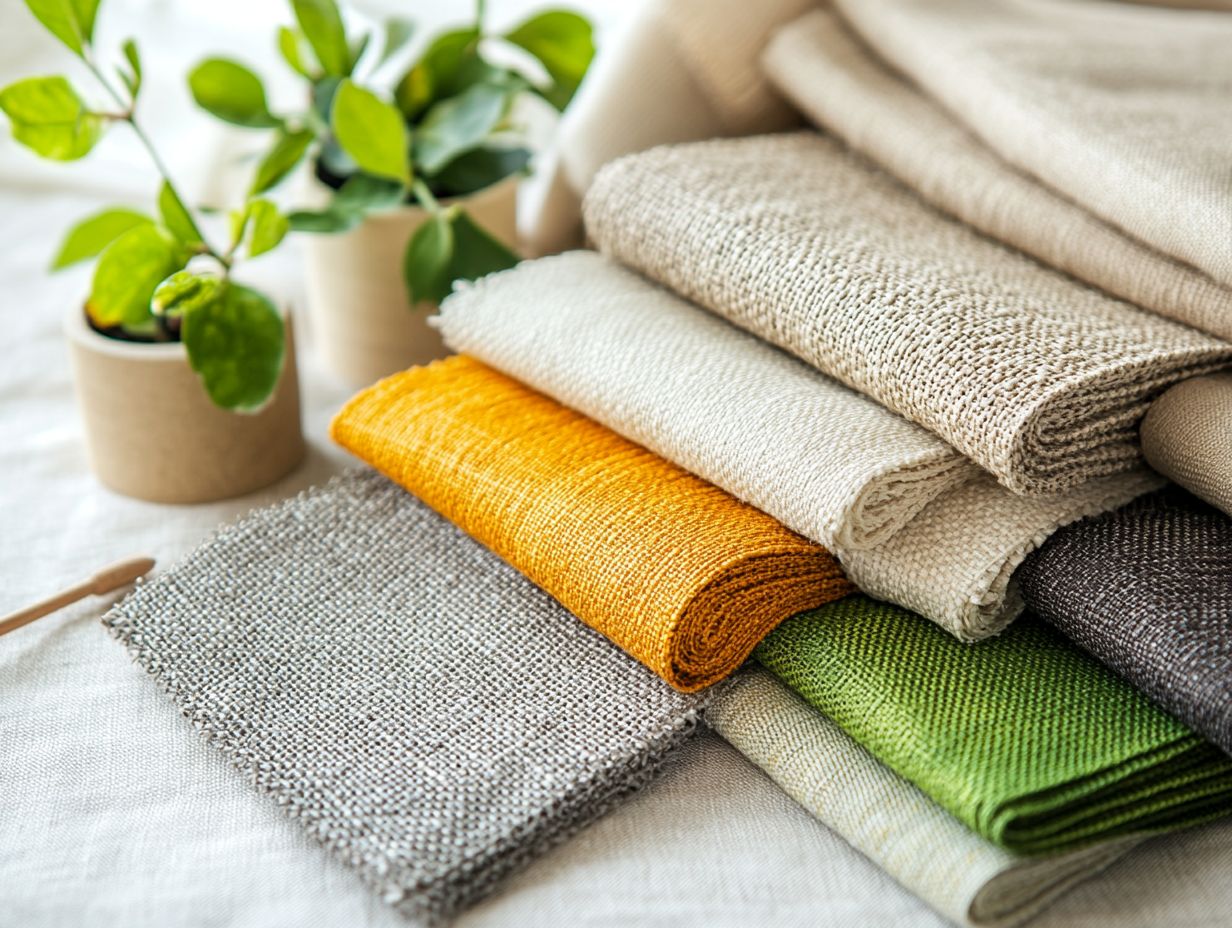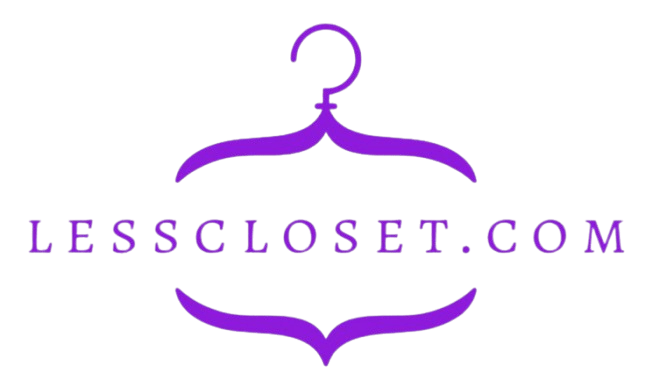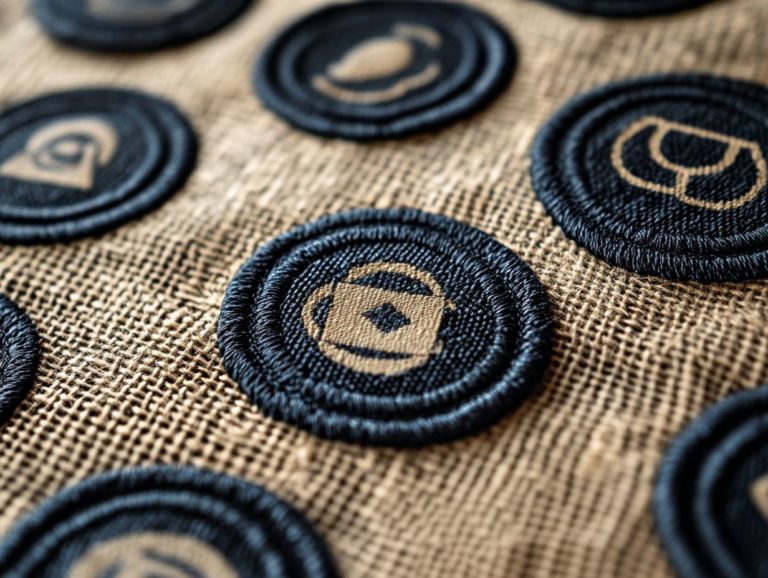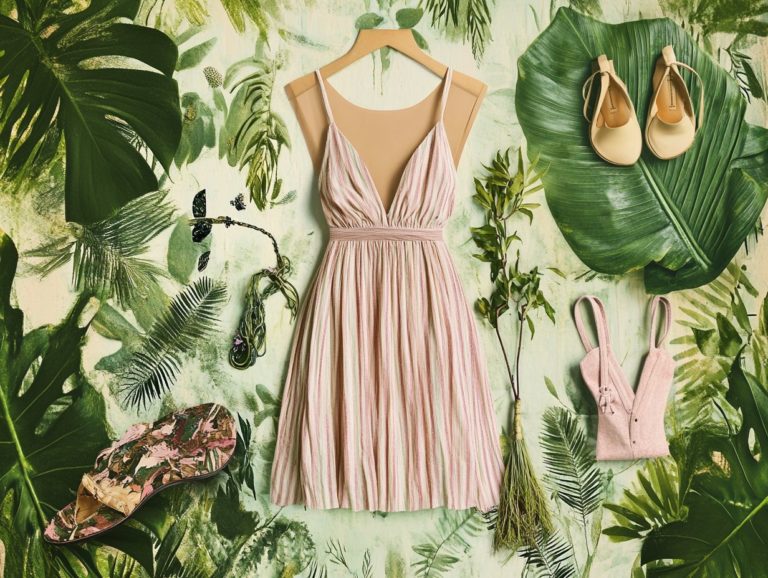Sustainable Fabrics: A Guide to Eco-Friendly Choices
In a world that s becoming more conscious of its environmental impact, your choice of fabrics is pivotal in embracing sustainable living. Sustainable fabrics not only minimize harm to the planet but also provide numerous benefits, including social responsibility and remarkable durability.
Get ready to explore the exciting world of sustainable fabrics! This guide will walk you through what sustainable fabrics are, the various types available, and how to identify and shop for eco-friendly options with confidence. By doing so, you contribute to reducing textile waste.
You ll also discover tips on how to incorporate these fabrics into your wardrobe in a stylish and responsible manner. Make the switch today and join the movement toward a more sustainable future!
Contents
- Key Takeaways:
- What are Sustainable Fabrics?
- Benefits of Choosing Sustainable Fabrics
- Types of Sustainable Fabrics
- How to Identify and Shop for Sustainable Fabrics
- Incorporating Sustainable Fabrics into Your Wardrobe
- Styling and Caring for Sustainable Fabrics
- Frequently Asked Questions
- What does it mean for a fabric to be sustainable?
- What are examples of sustainable fabrics?
- How do sustainable fabrics differ from conventional fabrics?
- Why choose sustainable fabrics?
- Where can I find sustainable fabrics?
- Are sustainable fabrics more expensive?
Key Takeaways:

- Choose sustainable fabrics to reduce environmental and social impact while enjoying high-quality, long-lasting products.
- Seek out certifications and labels to identify sustainable fabrics, and consider natural, organic, recycled, and upcycled options when shopping.
- Incorporate sustainable fabrics into your wardrobe with confidence by styling and caring for them properly.
What are Sustainable Fabrics?
Sustainable fabrics are thoughtfully crafted materials aimed at reducing their environmental impact throughout their lifecycle. By promoting environmentally friendly fabrics, they play a vital role in tackling pressing issues like textile waste, global warming, and microplastic pollution.
You ll find a diverse array of options, including hemp fabric, bamboo fabric, and Tencel Lyocell each boasting biodegradable properties and derived from plant-based fibers.
In an ever-evolving fashion industry that is increasingly conscious of its carbon footprint, embracing green fashion and the principles of slow fashion which means valuing quality and sustainability over fast production is essential for fostering a more sustainable future.
Defining Sustainable and Eco-Friendly
Defining what it means to be sustainable and eco-friendly involves a nuanced understanding of the materials and practices that prioritize environmental preservation while ensuring quality. Think organic cotton and biodegradable fabrics; these are staples in the realm of green fashion.
This approach stands in stark contrast to conventional practices that often rely on synthetic textiles like polyester. Not only do these materials contribute to pollution during production, but they also create significant challenges when it comes to disposal. For example, conventional cotton farming typically relies on pesticides and consumes vast amounts of water, while organic cotton is grown without harsh chemicals and uses water far more efficiently.
Regarding biodegradable options, those crafted from natural fibers break down more effortlessly than traditional textiles, dramatically cutting down on landfill waste. By opting for eco-friendly fabrics, the fashion industry can pivot toward a model that minimizes environmental impact and cultivates a healthier future for both consumers and the planet.
Benefits of Choosing Sustainable Fabrics
Opting for sustainable fabrics brings a wealth of advantages that go beyond your personal wardrobe. These environmentally friendly textiles not only minimize environmental impact but also promote social equity.
These fabrics enhance the quality and longevity of your garments, all while reducing the fashion industry’s carbon footprint. Making this choice is not just a personal decision; it’s a step toward a more responsible and impactful future.
Share your sustainable fabric choices on social media and inspire others to make eco-friendly decisions!
Environmental and Social Impact
Choosing eco-friendly textiles lowers the carbon footprint of the fashion industry while supporting ethical practices that improve labor conditions.
When you prioritize materials such as organic cotton, hemp, and recycled polyester, you significantly reduce pollution and resource consumption. For example, organic cotton saves about 91% of water compared to conventional methods. This not only conserves precious resources but also minimizes harmful runoff that can jeopardize local ecosystems.
On the social side, companies that embrace fair trade practices ensure that workers receive fair wages and work in safe conditions. Brands like Patagonia actively support artisans and uplift communities in developing regions. This focus on both environmental and social well-being shows how your choice of sustainable fabrics can drive meaningful change.
Quality and Longevity

Sustainable fabrics prioritize environmental impact while focusing on quality and longevity, making them a smart choice in green fashion. Products are designed to endure and stand the test of time.
These textiles often incorporate natural fibers and innovative processes to enhance durability, resulting in garments that resist wear and tear better than conventional options. By investing in pieces that look exceptional and align with a sustainable lifestyle, you reflect a growing awareness of the negative effects of fast fashion cheap clothing that is quickly made and sold on our planet.
By opting for durable options, you actively participate in a cycle of responsible consumption, embracing the idea that quality triumphs over quantity. Your smart choices can lead to a brighter, more sustainable future for all!
Types of Sustainable Fabrics
You ll find an array of sustainable fabrics, each catering to the eco-conscious consumer in unique ways.
Natural options like hemp and bamboo provide a refreshing touch, while organic fabrics, such as organic cotton, prioritize your comfort and the environment.
Innovative materials from recycled or upcycled sources upcycled means using old materials to create something new like Tencel Lyocell, showcase the beauty of sustainability without compromising quality.
Each choice you make contributes to a more mindful approach to fashion.
Natural and Organic Fabrics
Natural and organic fabrics, such as hemp, bamboo, and organic cotton, are celebrated for their ability to break down naturally and minimal environmental impact throughout their lifecycle.
These fabrics are grown without harmful pesticides or synthetic fertilizers, ensuring the soil remains fertile and promoting biodiversity in ecosystems. The fashion industry is taking notice of these sustainable options as brands strive to create eco-friendly collections that resonate with your desire for transparency and sustainability.
Take hemp, for example it’s renowned for its durability and versatility, finding its way into everything from activewear to high-fashion pieces. Bamboo fabric, on the other hand, boasts a soft texture and impressive moisture-wicking properties, making it perfect for athletic wear.
As awareness of the negative effects of conventional textile production spreads, the movement toward natural and organic materials, including ECONYL and Bananatex, is gaining momentum, reshaping modern fashion in ways that align with your values.
Recycled and Upcycled Fabrics
Recycled and upcycled fabrics offer a creative way to tackle textile waste. They transform discarded materials into stylish, eco-friendly textiles that elevate sustainable fashion.
This innovative approach conserves valuable resources and reduces the fashion industry’s environmental footprint. By reimagining old clothing or fabric scraps into fresh designs, brands are changing how sustainability is viewed by consumers.
Many forward-thinking companies lead this movement. They provide products that blend function and flair while supporting a circular economy.
These brands show that sustainability and style can coexist. You can choose options that align your values with your wardrobe.
How to Identify and Shop for Sustainable Fabrics
Identifying and shopping for sustainable fabrics may seem daunting. Familiarizing yourself with essential certifications (official stamps that guarantee quality) and labels (tags that provide information), like the Greenguard Gold Certification, will help you make informed choices that resonate with your eco-friendly values.
This knowledge empowers you to select materials that look great and contribute positively to the environment.
Certifications and Labels to Look For

When shopping for sustainable fabrics, seek certifications and labels that confirm eco-friendly claims. Look for the Greenguard Certification and others that support sustainability and responsible sourcing.
These certifications are reliable indicators of a fabric’s environmental impact. For example, the Oeko-Tex Standard 100 ensures textiles are free from harmful substances. The Global Organic Textile Standard (GOTS) guarantees the use of organic fibers and ethical labor practices.
Don’t overlook the Forest Stewardship Council (FSC) label, which indicates sustainably sourced wood-based materials. Understanding these certifications empowers you to make informed choices in a marketplace filled with eco-friendly claims.
By seeking trustworthy labels and brands, like those approved by Greenguard Certification, you play a vital role in fostering a sustainable future.
Tips for Finding Sustainable Options
Finding sustainable options in fashion requires intentionality and knowledge. Research brands prioritizing ethical fashion and eco-friendly textiles.
Understanding a brand’s practices can reveal the materials they use, such as hemp or bamboo fabric, and how they source them. Look for certifications like Fair Trade or Greenguard Gold Certification, which indicate a genuine commitment to sustainability.
Be aware of marketing tactics; some companies use greenwashing to create an illusion of eco-friendliness without truly being sustainable. By adopting mindful shopping habits, you reduce waste and support companies dedicated to ethical standards and environmental responsibility, like Indian Dream and The Harra Label.
Incorporating Sustainable Fabrics into Your Wardrobe
Incorporating sustainable fabrics, like organic cotton, hemp, and Tencel Lyocell, showcases your values and aligns you with a movement toward eco-friendly textiles.
Understanding the styling and care practices of these garments can enhance their longevity and impact. Be mindful of their water consumption to make a positive difference.
Styling and Caring for Sustainable Fabrics
Proper styling and care for sustainable fabrics maximize their lifespan and preserve their beauty. Enjoy eco-friendly textiles and help reduce microplastic pollution for years to come.
Select outfits made from organic cotton, hemp, bamboo, or Tencel. These materials let you create stylish, environmentally-friendly looks.
Imagine pairing a lightweight linen dress with sustainable accessories. It’s perfect for brunch or a charming garden party while keeping your environmental impact low.
To maintain these fabrics, wash gently in cold water and air dry. These small changes significantly reduce wear and tear on your favorite pieces.
Frequently Asked Questions
What does it mean for a fabric to be sustainable?

A fabric is sustainable if it’s made with methods that have minimal environmental impact. This includes reducing water use and ensuring fair treatment of workers.
What are examples of sustainable fabrics?
Examples include organic cotton, bamboo fabric, hemp fabric, linen, and Tencel. These materials are natural, renewable, and biodegradable.
How do sustainable fabrics differ from conventional fabrics?
Sustainable fabrics are made from natural materials and produced using eco-friendly methods. They typically have a lower environmental impact and are often ethically sourced.
Why choose sustainable fabrics?
Sustainable fabrics are better for the planet and support ethical practices in fashion. They promote a healthier lifestyle for consumers and workers alike.
Where can I find sustainable fabrics?
Look for eco-friendly brands like Doodlage and Leafaffa. You can also check specialty stores or online retailers for sustainable options.
Are sustainable fabrics more expensive?
Some sustainable fabrics may cost more than conventional ones. However, the long-term benefits and support for ethical practices make them worth the investment.






